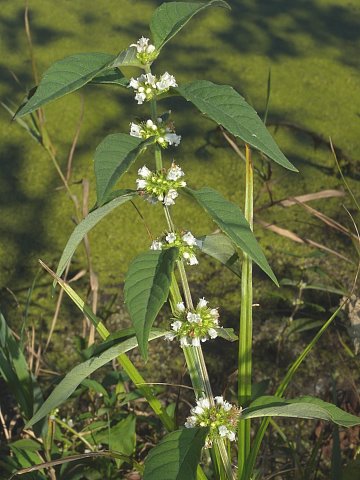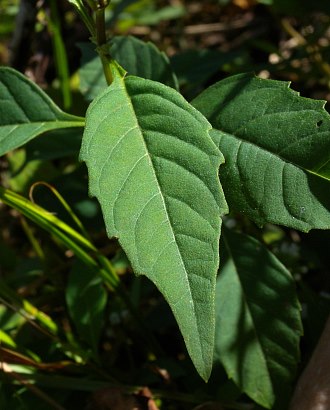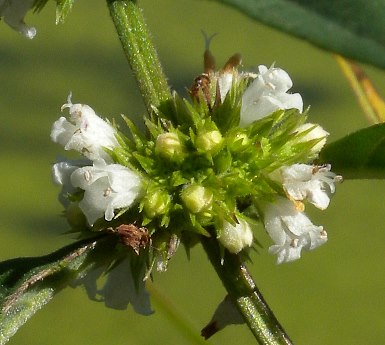
Dense clusters of nearly sessile flowers occur along the middle to upper leaves; they are whorled around the central stem and located above the petioles of the leaves. Each flower consists of a light green calyx with 4-5 teeth, a white short-tubular corolla with 4-5 lobes, 2 slightly exerted stamens, and a pistil. The corolla is 3-5 mm long, while the calyx is 2-3 mm. long and its teeth are narrowly triangular. The blooming period occurs from mid-summer into the fall, lasting about 2-3 months. Usually, relatively few flowers are in bloom at the same time. Each flower is replaced by 4 nutlets about 1.0-1.5 mm. long; these nutlets are 3-angled and obovoid-oblong in shape; their upper surfaces are tuberculate (bumpy), particularly along their outer margins. The root system is rhizomatous or stoloniferous; it usually forms tubers. Small colonies of plants are often produced from the rhizomes or stolons.
Cultivation: The preference is partial sun, wet to moist conditions, and soil containing some sand and organic material, although other soil types are tolerated.

Range & Habitat: The native Stalked Water Horehound is scattered across most areas of Illinois, where it is uncommon to occasional (see Distribution Map). Habitats consist of openings in floodplain woodlands, swamps, soggy thickets and meadows, and low areas along pools of water. Sometimes Stalked Water Horehound is found on rotting tree trunks that have fallen over, and in mossy areas near the bases of trees. The wetlands where this wildflower occur are often partially shaded, protected from prevailing winds, and somewhat sandy.
Faunal Associations: There are no records of floral pollinators for Stalked Water Horehound, but they are probably similar to those of Lycopus americanus (Common Bugleweed). These pollinators consist of insects, including long-tongued bees, short-tongued bees, wasps, and flies. The tubers of Stalked Water Horehound and other tuberous Lycopus spp. are eaten by muskrats. Because the foliage is bitter-tasting, it is rarely bothered by mammalian herbivores.

Photographic Location: A sandy swamp at the Heron Boardwalk in Vermilion County, Illinois. The photographed plants were growing near a rotting log along a pool of water.
Comments: The flowers of Stalked Water Horehound are a little larger and showier than the flowers of other Lycopus spp. in Illinois. The species in this genus are similar in appearance and they are rather difficult to distinguish. Stalked Water Horehound has petioled leaves with 3-5 teeth (less often 0-2 teeth) along their margins, and the calyces of its flowers have narrowly triangular teeth. These calyces exceed 2 mm. in length (including their teeth). In contrast, some species in this genus have more teeth along their leaf margins, or their lower leaves are lobed; and some species have shorter toothed calyces (less than 2 mm. in length).